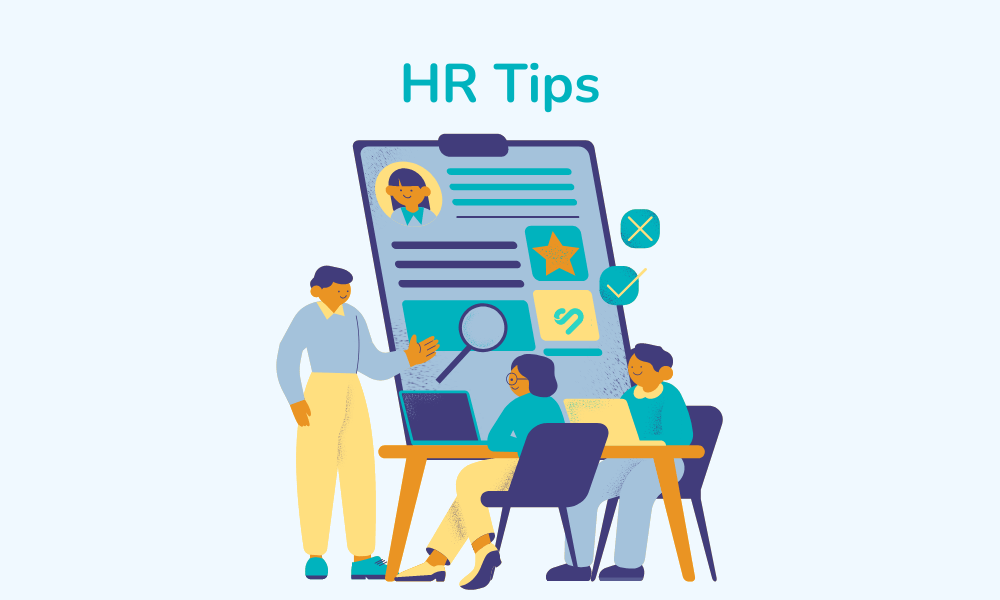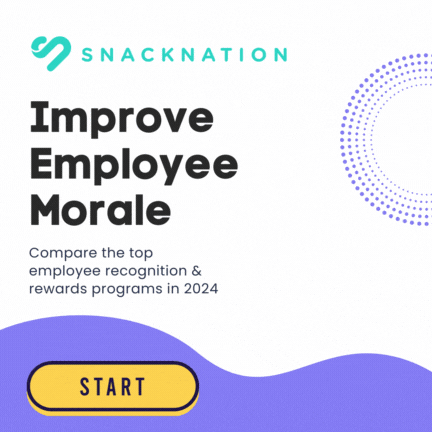In the fast-paced circus of business, human resource management emerges as the backbone of organizational harmony, keeping multiple plates spinning simultaneously.
In today’s fast-paced and dynamic business landscape, effective HR tips are essential for attracting top talent on HR job posting websites, enhancing employee engagement, and driving organizational success.
Pro-Tip from Human Crapital: “Hire for Attitude, Train for Skills!” means skills are trainable, but a positive attitude and alignment with your organization’s values are the secret sauce that crafts a dynamic and united team.
These guided collections of essential know-how and HR tips promise to empower you with cutting-edge strategies, innovative technologies, and a forward-thinking mindset, ensuring you lead your organization toward a brighter and more successful future.
Tip! Try these FREE email newsletters to gain resources and insights into being a better professional:
| The Assist | 💼 Become a better professional in under 5 minutes | Subscribe Here |
| FounderIV | ⚡Achieve breakout founder performance with this free weekly email | Subscribe Here |
| Human Crapital | 🤭 Helping you avoid embarrassing, uncomfortable, and common HR mistakes | Subscribe Here |
Page Contents (Click To Jump)
Understanding HR Best Practices
In the rapidly changing landscape of the modern world, HR best practices have evolved from conventional processes to transformative strategies that focus on elevating human potential. This progressive approach recognizes that organizations thrive when they invest in their most valuable asset—their people.
By nurturing a culture of continuous learning, empowerment, and inclusivity, HR best practices aim to unlock employees’ full potential, creating a workforce that is not only engaged but also inspired to contribute to the organization’s success.
Key HR Responsibilities
🔎 Recruitment and Selection
Organizations view the hiring process as an opportunity to strategically curate talent that aligns with their long-term business goals. Rather than focusing solely on immediate job requirements, strategic talent curation considers the potential for growth, adaptability, and cultural fit within the organization.
🏅 Performance Management
As one of the key elements of HR, organizations create an environment where employee performance is not merely assessed but actively nurtured and elevated. This innovative approach drives a culture of continuous learning, growth, and appreciation, fostering a high-performance workforce that is motivated, engaged, and aligned with the organization’s success.
📚 Learning and Development
Organizations can revolutionize their approach to Learning & Development, creating a dynamic and adaptive learning ecosystem that nurtures employees’ potential and contributes to the organization’s long-term success. This people-centric HR element not only elevates employee growth but also strengthens the organization’s competitive edge in an ever-changing world.
📈 Succession Planning
Implementing a dynamic succession planning strategy communicates to potential hires that the organization values employee development and offers growth opportunities. This attracts top talent seeking career progression and leadership prospects. Additionally, a well-structured succession planning program increases employee retention as employees feel more invested in the organization’s long-term vision and career trajectories.
💰 Compensation and Benefits
Personalized compensation and benefits packages align with the diverse needs of employees, resulting in higher job satisfaction and engagement. When employees feel that their unique contributions and circumstances are acknowledged and rewarded, they are more motivated to perform at their best, leading to increased productivity and commitment to the organization.
🖥️ Human Resources Information Systems
By analyzing HR data alongside financial and operational data, HR professionals can identify the right talent mix required for future growth and respond proactively to changes in the business environment.
📊 HR Data and Analytics
People-driven predictive analytics empowers HR to make data-backed decisions on workforce planning. HR professionals can anticipate future talent needs, identify skill gaps, and develop strategies to attract and retain top talent. This strategic approach aligns HR initiatives with the organization’s long-term goals, driving overall success.
Examples of Good HR Practices
LinkedIn is known for its commitment to diversity and inclusion. The company has established employee resource groups to support underrepresented communities and has implemented unconscious bias training for employees involved in hiring and promotion decisions. LinkedIn also encourages employees to participate in volunteer activities and supports various social impact initiatives.
⭐ Netflix
Netflix is known for its unique approach to HR, which emphasizes trust and autonomy. The company does not have a formal vacation policy, allowing employees to take time off as needed and trusting them to manage their schedules responsibly. Netflix also focuses on hiring high-performing individuals and offers competitive compensation packages to attract and retain top talent.
Google is renowned for its innovative and employee-centric HR practices. The company offers a wide range of perks and benefits, including free gourmet meals, on-site healthcare services, and generous parental leave. Google also encourages a culture of continuous learning through initiatives like “20% time,” where employees can dedicate 20% of their work hours to pursue passion projects. The company’s approach to performance management emphasizes regular feedback and coaching conversations, promoting a growth mindset among its employees.
⭐ Patagonia
Patagonia is an example of a company that prioritizes sustainability and social responsibility in its HR practices. The company goes the extra mile to provide ample employee benefits that promote work-life balance, such as on-site child care, flexible work schedules, and paid time off to participate in environmental activism. Notably, the company also allocates a portion of its profits to support environmental causes while actively championing sustainable business practices.
⭐ Adobe
Adobe is recognized for its strong commitment to employee growth and development. The company provides extensive learning and development opportunities, including access to online courses and skill-building workshops. Adobe also encourages a work culture of innovation and creativity, allowing employees to pursue passion projects and explore new ideas.
8 Essential HR Tips
1. Build Effective Hiring Practices 🤝
Effective hiring practices extend beyond the initial onboarding period. Organizations that provide ongoing support, mentoring, and regular check-ins with new hires demonstrate their commitment to their employees’ success and well-being.
Such continuous support fosters a sense of belonging and loyalty, contributing to higher employee retention rates.
2. Create Strong Onboarding Procedures ✅
Creating strong onboarding procedures can transform the onboarding process into a nurturing, engaging, and growth-oriented experience for new hires.
By prioritizing people management and embracing innovative technology, organizations can build a cohesive and connected workforce from day one, fostering higher employee satisfaction, productivity, and retention in the long run.
3. Establish a Performance Management System 🏅
A performance coaching culture prioritizes the importance of regular feedback exchanges between managers and team members. This ongoing feedback loop provides timely guidance, acknowledges achievements, and identifies areas for improvement.
By embracing continuous feedback, organizations create an agile workforce that adapts quickly and consistently improves performance.
4. Foster Clear Communication Channels 📣
When employees have a say in shaping communication channels, the resulting framework is more likely to be relevant and effective. Different teams may have unique communication preferences, and by tailoring the channels to suit their needs, organizations can ensure that information is conveyed in a manner that resonates with team members.
5. Offer Employee Development and Training 📚
Short and focused microlearning modules improve knowledge retention compared to traditional lengthy training and development sessions. Employees are more likely to absorb and retain information when it is presented in easily digestible chunks, leading to a more effective and impactful training experience.
6. Develop Fair Compensation and Benefits Packages 💰
By offering flexible benefit customization, organizations acknowledge the diverse needs of their workforce, promoting work-life balance. Employees can choose benefits like remote work options, wellness programs, or additional time off, enabling them to achieve a healthier work-life integration.
7. Implement Employee Recognition and Rewards 🥳
Employee recognition and rewards play a crucial role in shaping company culture. A values-driven rewards program reinforces the behaviors and attitudes that define the organization’s unique culture, creating a cohesive and purpose-driven work environment.
8. Prioritize Employee Well-being Initiatives 🧘
Data-driven well-being analytics allow HR teams to identify specific pain points and challenges faced by employees. By understanding the unique well-being needs of their workforce, HR departments can implement initiatives that directly address these areas, fostering a more meaningful impact on employee well-being.
Bonus! Continuously Search for New HR Resources 📚
By embracing a forward-thinking HR role, HR professionals can future-proof HR strategies. They can anticipate upcoming challenges and opportunities and develop proactive solutions to stay ahead in a rapidly changing business environment.
New resources, such as cutting-edge HR technology, AI-driven analytics, and data-driven tools, enhance HR operations and decision-making. Embracing innovation empowers the human resources department to be more agile, efficient, and strategic in its approach.
People Also Ask These Questions About HR Tips
Q: What are the best HR tips for employee retention?
- A: The best HR tips for employee retention revolve around creating a culture of appreciation and recognition, where employees feel valued and acknowledged for their contributions. Offering attractive benefits and growth opportunities tailored to individual needs and career aspirations also plays a pivotal role in retaining top talent. Additionally, fostering open communication and providing avenues for professional development and skill enhancement can significantly enhance employee loyalty and commitment to the organization.
Q: How can I improve my HR skills?
- A: As an HR leader, you can collaborate with leaders and professionals from various departments, fostering cross-functional learning opportunities. By exchanging insights and experiences with individuals from diverse backgrounds, you can gain a broader understanding of the organization’s challenges and goals, enhancing your HRM expertise.
Q: What are some employee engagement strategies for remote teams?
- A: Thriving HR teams have the power to inspire employees to become remote work advocates, sharing their experiences through various social media channels. These ambassadors can leverage platforms like LinkedIn, Twitter, or Instagram to showcase the perks and pleasures of remote work, crafting a positive narrative that strengthens the remote work culture and underscores the company’s dedication to employee welfare. You can also subscribe to HR newsletters and follow up with a variety of HR blogs to get new and fresh ideas about employee engagement strategies.
Q: What are the key challenges in HR management?
- A: The field of HR management encounters a wide array of challenges, spanning from talent recruitment and retention to fostering diversity and inclusion, incorporating HR technology, and prioritizing employee well-being. By skillfully interacting with stakeholders and comprehending their requirements, HR teams can devise personalized strategies that harmonize with the organization’s overarching goals.
Q: What are the legal compliance requirements for HR?
- A: The legal compliance requirements for HR can vary depending on the country, industry, and size of the organization. Generally, HR teams must adhere to labor laws, anti-discrimination regulations, and employee rights protections. They should also ensure proper record-keeping, confidentiality, and data protection in line with relevant privacy laws to avoid legal liabilities and maintain a fair and safe workplace for employees.










